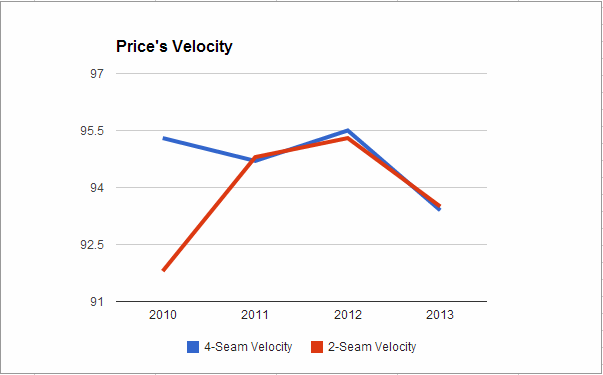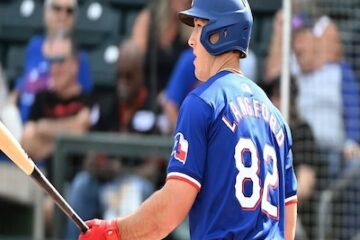2014 Fantasy Baseball: Early Top 20 SP For 2014 Part II


We’re finally winding down early ranking season. After this piece, we’ll only have the most speculative position in fantasy baseball left – closers. Before we make our way down that road, let’s finish out starting pitchers.
Part I, which can be found here, saw the “whose who” of pitchers come off of the board. At this point, Clayton Kershaw is long gone. Yu Darvish, Max Scherzer, and Adam Wainwright are all also a memory. Fret not, there is still plenty of talent left on the board. In fact, I usually purposely wait until this tier to pick the “anchor” of my staff, because the price is much more palatable.
The next 10 guys are likely not going to be a huge bargain on draft day, but they’re good enough to be considered “safe” and possibly return a little surplus value in the process. Let’s rank ’em.
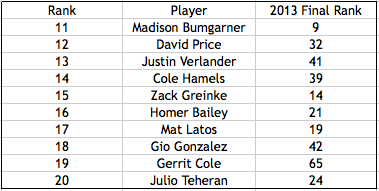
Madison Bumgarner is quite possibly one of the most underrated players in fantasy year in and year out. In 2012, his ADP (ESPN) was 89th. He finished the season as the 14th best pitcher; and 52nd overall. In 2013, his ADP was more expensive. He was drafted on average, 54th overall. Surplus value still abounded because he finished the year at the 9th best pitcher and 40th overall.
Bumgarner, for whatever reason, is rarely mentioned when people discuss the upper echelon of starting pitchers. That will, or at least it should, as everyone begins preparing for 2014. Bumgarner has thrown at least 200 innings, struck out greater than 8 batters per 9 innings, and had an ERA below 3.38 for the past 3 years. If you feel like waiting a little on SP and missing the “aces,” Bumgarner is a hell of a consolation prize.
Twelfth may seem low for David Price, but I promise I have reasons! Price was good in 2013, unfortunately there are a few things about him that worry me going forward. The rate at which he struck hitters out declined to a career low – excluding the rookie version of Price in 2009. Coupled with fewer strikeouts came lower velocity.
Luckily for Price, his velocity was declining from career highs. He still throws hard, but the difference between 95 mph on average and 93 mph on average is substantial. To take it a step further, glance at Price’s whiff (swing-and-miss) percentage on each pitch in his arsenal in 2013 compared to his Cy Young winning 2012.

Hitters were much better at making contact against all of Price’s offerings in 2013, except for his change up. The most marked difference comes on his curveball. Obviously, hitters were not fooled as much in 2013 versus his hook. Price’s curveball was bashed to the tune of a .520 slugging percentage in 2013 after only be touched up for a minuscule .168 slugging percentage in 2012. The pitch should not get hit that hard in 2014, mainly because it’s tough for batters to slug .520 in general, but it’s cause for concern.
It isn’t all bad news though. Even though his strikeouts declined, Price essentially decided he wouldn’t walk anyone – especially after he returned from his DL stint. His 3.7% walk rate was tied with Cliff Lee and Adam Wainwright for the best in the majors, among starters. Some of Price’s game is worrisome, but he’s still very good at preventing runs and minimizing damage he inflicts upon himself. He should be plenty good in 2014; just don’t expect a bounce back to his 2012 numbers and you shouldn’t be disappointed.
For all that was said about Justin Verlander in 2013, he was still pretty good. Granted, he wasn’t the Verlander that we’re used to seeing, but reports of his demise seem very premature. After struggling a little at times throughout the season he was dynamite down the stretch, posting a 2.27 ERA and his best K/BB ratio of the season in September and October. Fangraphs‘ Eno Sarris noticed a change in his release points that possibly helped him regain his form a little during the home stretch of the season. Verlander should be good to go in 2014, especially with an improved defense behind him. He could quite possibly be a bargain on draft day, which has not been the case in a few seasons.
Cole Hamels‘ is fine. No really, if you were at all worried about him because of his slow start in 2013, don’t be.

Hamels just had a rough patch, once May ended he was just as good if not better than he has been during his entire career. (ROS = rest of season) I’m not worried at all about him going into 2014, in fact I’m hoping his value isn’t quite as shiny so I can pick him up in nearly every league I’m in.
Zack Greinke has been somewhat of a sabermetric darling for quite some time due to his sparkly peripherals. However, his “classic” stats – mainly his ERA – lagged behind a little. In 2013, the roles were reversed and Greinke’s ERA was finally better than his FIP (fielding independent pitching). Greinke’s 2.63 ERA was the second lowest of his career, coming in only behind his stellar 2.16 ERA during his 2009 Cy Young campaign, and the first time he’s had an ERA below 3.48 in the same time frame.
Greinke had to somewhat find a new way to pitch for parts of 2013. There were early reports of elbow soreness and then he suffered a broken collarbone during the brawl with San Diego. The end game of both of those situations culminated in Greinke scrapping his slider in favor of a cutter. Many pitchers have made the decision to tone down their slider usage in order to protect their elbow a little more. For some reason, though, two of the sites I frequent for pitch f/x information disagree on Greinke’s pitch mix last year. Texas Leaguers says he threw more cutters, but Brooks Baseball has him throwing more sliders. It’s probably a clarification issue with the system and not that large of an issue. I used FanGraphs’ pitch f/x numbers in order to break the tie. Their data agreed with Texas Leaguers’ so we’re going with more cutters!
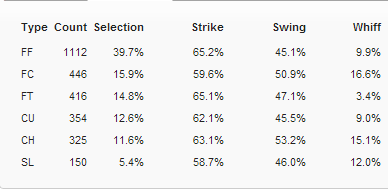
*For the record, FF = 4-seam fastball, FC = cutter, FT = two seam, CU = curve ball, CH = change-up, SL = slider.*
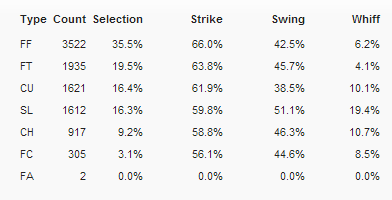
As you can see, the usage of the slider dropped off roughly 10% while the cutter usage spiked nearly 12%. It’s hard to argue with the results Greinke got out of the deal, at least in the scope of a full season. Greinke’s cutter produced a higher whiff rate than anything else he threw. Greinke is a smart pitcher though and he even adjusted further in order to keep hitters guessing.
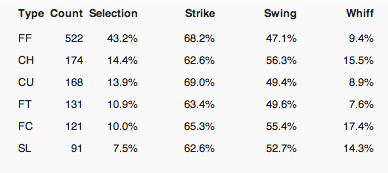
This is, very likely, Greinke’s optimal pitch mix based on his current stuff (diminished velocity, etc.). Down the stretch, the opposing opposition had absolutely no idea what was coming. Greinke essentially throws six different pitches. His pitch mix from the time frame shown above saw his whiff rates on 4 pitches improve, likely due to the inability for hitters to sit on a pitch. The end result ended up having Greinke increase his K% to 22% in the second half from 19% in the first half. That might seem insignificant, but as we’ve established, having fewer balls put in play is ideal.
Greinke has been a very good pitcher the past few years, but he once again was elite in 2013. His strikeouts were down a little, but he posted his best ERA and WHIP since 2009 and could have possibly won more games if he wasn’t sidelined for a month. Greinke’s a good pitcher that is surrounded by a good team and he pitches in a ball park well suited for him; draft him with confidence.
Homer Bailey was similar to Anibal Sanchez in 2013, in the sense that I perceived him to be undervalued and targeted him in my leagues. It worked out pretty well considering Bailey took significant strides towards being one of the game’s better starters. Dave Cameron wrote a nice piece on Bailey’s ascension that is pretty concise, so for the sake of saving time and space, I’ll defer to him on the matter.
Remember the trade that sent Mr. Latos to Cincinatti? There was seemingly so much talk about how the Reds overpaid for Latos’ potential because he “only went 9-14 in 2011.” Hindsight is always 20/20, but man that move looks damn good now. Latos’ 2013 campaign was basically a mirror image of his 2012 one; except with a few less dingers. In fact, aside from losing roughly a strikeout per 9, he’s been roughly the same pitcher for the last 4 seasons. Obviously losing a strikeout per nine is something, but he’s still around eight, so we’re good there. The velocity is good, hitters still chase out of the zone against him, and he has shown he’s capable of going over 200 innings twice. All is well.
Gio Gonzalez is inconsistent. He’s similar to Alex Rios; a pain to own in a head to head league at times, but fine once you zoom out to view the season as a whole. He has sub-par command, which makes him a liability to give up big innings and have an inflated WHIP. He’ll likely never be an asset in that category. On the bright side, he strikes out hitters at a stellar rate and is perfectly adept at preventing runs.
I’m not enamored with him and the command issues are worrisome. Despite his issues with command, his zone% (pitches thrown inside the strike zone) has stayed relatively stable over the past few years (per pitch f/x). He’s still getting hitters to chase at an above league average rate and generating a swinging strike rate that’s better than league average. He’s tough to own at times, but he’s relatively safe and offers a little bit of upside.
I love Gerrit Cole. He’s my new fanboy pitching crush; taking over the spot previously held by Brandon Anderson and his sexy back-foot breaking ball (get healthy, please). I love him so much that I wrote over 1,800 words about him and his growth throughout the season in late September. After I wrote that article he performed very well on a big stage in the postseason, so his draft price might be a little higher. He could still provide surplus value, and I like him better than Michael Wacha for 2014, if we’re choosing between postseason inflated ADPs. Check it out if you’re interested in some pretty charts. Spoiler alert: he’s going to be very very good.
As a Braves’ fan and an resident in the Atlanta metro area it was very nice to see Julio Teheran put together the year he did in 2013. Everyone was finally able to see the potential that had been written about him for what seems like a lifetime.
Teheran was good, but I believe he’s got a little more in the tank. Even though, he was top 25 in K%, I believe he can muster a few more. I’m basing that on the fact that his swinging strike percentage (swstr%) was a little better (19th in among starters). I’m also still holding out hope for his change-up to be implemented a little more and become the plus offering we’ve heard so much. Without the change-up he’s good; with it, he could be absolutely dominant.
Remember those David Price whiff rates from earlier in the piece? Price had 3 pitches with a 20% or better whiff rate in 2013 – ranging from 20% to 29.45%. Julio Teheran was able to generate whiff rates greater than roughly 23% on 4 offerings – including whopping 37.54% and 37.10% rates on his slider and change-up, respectively. Those are pretty elite numbers and it seems to be just the beginning.
His ability to strike out batters coupled with his penchant for limiting free passes is a good recipe for future success. He is a flyball pitcher, so homer issues, could arise at some point, but he also has a solid defensive outfield behind him in the Uptons (Schafer if BJ struggles again) and Jason Heyward. Justin had a rough year in 2013 in the field, but it’s still a solid group nonetheless. And he has Andrelton Simmons covering the left side of the infield, so that has to count for something, right?
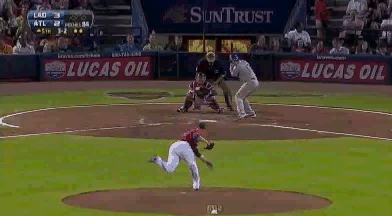
Honestly, I just wanted an excuse to plug in a GIF of Simmons playing defense. All jokes aside, I’m expecting a nice season out of Mr. Teheran and due to the strides he made in 2013; you should too.


